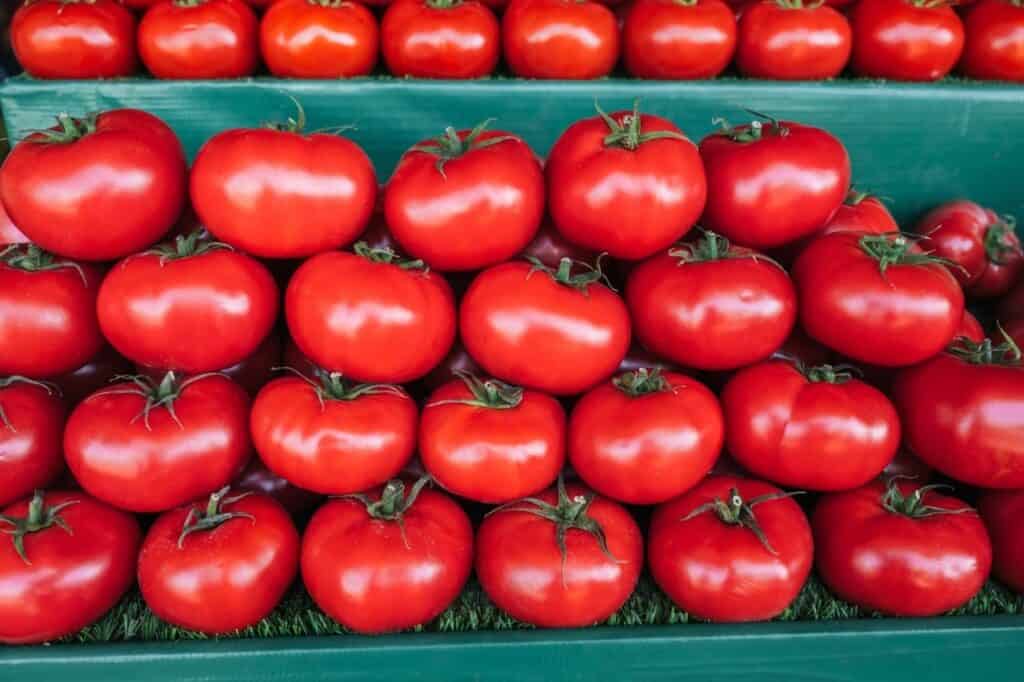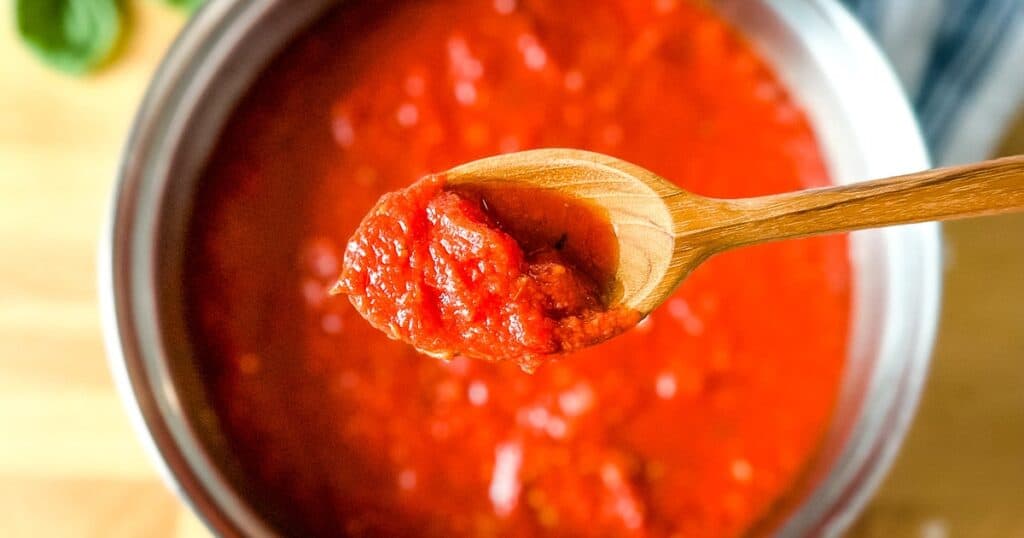Freezing tomatoes is a fantastic way to preserve their summer ripeness and flavor. Whether you use them in sauces, soups or stews, having frozen tomatoes on hand ensures you can enjoy their fresh taste throughout the year. Keep reading for a step-by-step guide on how to properly freeze tomatoes.

Method 1: Freezing whole tomatoes
This is the easiest and fastest way to freeze tomatoes. It’s great if you don’t mind keeping the skins on and you plan to use the tomatoes in soups or stews.
Step 1: Wash the tomatoes. Start by rinsing the tomatoes under cool running water to remove any dirt or debris. After washing, pat the tomatoes dry with a clean towel or paper towel. Drying them completely is important because it helps prevent ice crystals from forming during freezing.
Step 2: Remove the core. This is an optional step. Simply cut the center of the tomato in a cylindrical shape from the leaf end to the base with a small knife and remove the core.
Step 3: Freeze whole. Place the whole tomatoes on a baking sheet in a single layer, ensuring they aren’t touching. This prevents them from sticking together. Freeze the tomatoes on the sheet until they are completely solid. This takes a few hours.
Step 4: Transfer to freezer bags or containers. Once the tomatoes are frozen solid, transfer them into freezer-safe bags or airtight containers. Squeeze out as much air as possible to prevent freezer burn, and seal the bags tightly. Label the bags with the date so you can keep track of their freshness.

Method 2: Freezing blanched, peeled tomatoes
Blanching and peeling the tomatoes before freezing is ideal if you prefer skinless tomatoes in your recipes. This method is great for sauces and other dishes that require a smoother texture.
Step 1: Wash the tomatoes. As with freezing whole tomatoes, begin by washing the tomatoes thoroughly under cool running water to remove dirt. Dry them completely before moving on to the next step.
Step 2: Prepare for blanching. Blanching makes it easy to remove the tomato skins. Bring a large pot of water to a boil. Meanwhile, prepare a bowl of ice water to cool the tomatoes after blanching. Before boiling, use a small knife to score a shallow X on the bottom of each tomato. This will help the skin peel off easily later.
Step 3: Blanch the tomatoes. Drop the tomatoes into the boiling water for 30 to 60 seconds, just until the skins start to split. Don’t leave them in too long — you only want to loosen the skins, not cook the tomatoes. Immediately transfer the tomatoes to the ice water to cool quickly. This stops the cooking process and makes the skins easier to remove.
Step 4: Peel the tomatoes. Once the tomatoes are cool, the skins should slip off easily. Simply peel them away with your hands or a small knife.
Step 5: Core and freeze. After peeling, you can remove the core of each tomato if desired. Place the peeled tomatoes on a baking sheet in a single layer. Freeze them until solid, which usually takes a few hours.
Step 6: Transfer to freezer bags or containers. Once the tomatoes are frozen solid, transfer them into freezer-safe bags or airtight containers. Be sure to remove as much air as possible before sealing to prevent freezer burn. Label the bags with the date.
Method 3: Freezing cooked tomatoes
If you want to freeze tomatoes in the form of a ready-made sauce, soup or puree, this method is ideal. It allows you to preserve cooked tomatoes for quick and easy meal prep in the future.
Step 1: Prepare your tomato-based dish. Start by making your tomato recipe. You can season the dish with herbs and spices, but avoid adding cream or dairy if you plan to freeze soups or sauces — it’s best to add those ingredients fresh when reheating.
Step 2: Cool the cooked tomatoes. Once your tomato dish is finished cooking, let it cool completely. Cooling it before freezing helps maintain the texture. You can speed up the cooling process by placing the pot in an ice bath or letting the dish sit at room temperature for about an hour.
Step 3: Portion and freeze. Transfer the cooled soup, sauce or puree into freezer-safe containers. It’s helpful to freeze them in portion sizes, so you only defrost what you need later. If using bags, lay them flat in the freezer to save space and for quicker thawing.
Be sure to leave a little room at the top of the containers, as the liquid will expand as it freezes. Remove as much air as possible from freezer bags before sealing to prevent freezer burn. Label the bags or containers with the date and the type of sauce or soup.
Step 4: Freeze until solid. Place the containers or bags of cooked tomato soup, sauce or puree in the freezer. Once frozen solid, they will last for several months and be ready for use whenever you need them.
“Whenever I find myself with an abundance of fresh tomatoes, I love to roast them and make them into tomato soup, pasta sauce or pizza sauce, and then freeze any extra. It’s so nice to be able to taste a bit of summertime in the other seasons.”
— Susannah Brinkley-Henry, Feast + West
Reheating and serving tomatoes
Frozen tomatoes — whether whole or blanched — are best used in cooked dishes like soups, stews or sauces. Here’s how to use them:
For whole frozen tomatoes, you can thaw them overnight in the refrigerator or run the bags of frozen tomatoes under cool water for a quicker thaw. Once thawed, the skins can easily be removed if you choose to remove them. These tomatoes are perfect for rustic dishes where the skins will break down during cooking, like this hearty marinara sauce.

You can use blanched, peeled tomatoes directly from the freezer in recipes. They work well in sauces, soups, stews, cooked salsas and pasta dishes, like spaghetti tossed with tomato and mascarpone sauce or this spaghetti arrabbiata, where you need a smooth texture. You can also thaw them in the refrigerator overnight if you prefer.
If using frozen cooked tomatoes, they can be reheated straight from the freezer. You can thaw the cooked tomatoes in the refrigerator overnight or reheat them gently on the stovetop.
For a quicker method, you can reheat frozen cooked tomatoes in the microwave on the defrost setting, or immerse the sealed bag or container in a bowl of cool water to speed up the thawing process. Once thawed, they are ready for use.
Final thoughts
Freezing tomatoes is an excellent way to extend their shelf life and have them on hand for your favorite recipes year-round. Whether you freeze them whole or as a puree, both methods preserve their flavor for later use in cooked dishes. This simple process allows you to enjoy the taste of fresh tomatoes well beyond the summer season.
Gen is a professional chef, writer and editor living in Southern California. She is the owner and recipe creator behind Two Cloves Kitchen, a food site featuring contemporary, California-inspired recipes. She has edited over 20 novels, short stories and essays for publication.